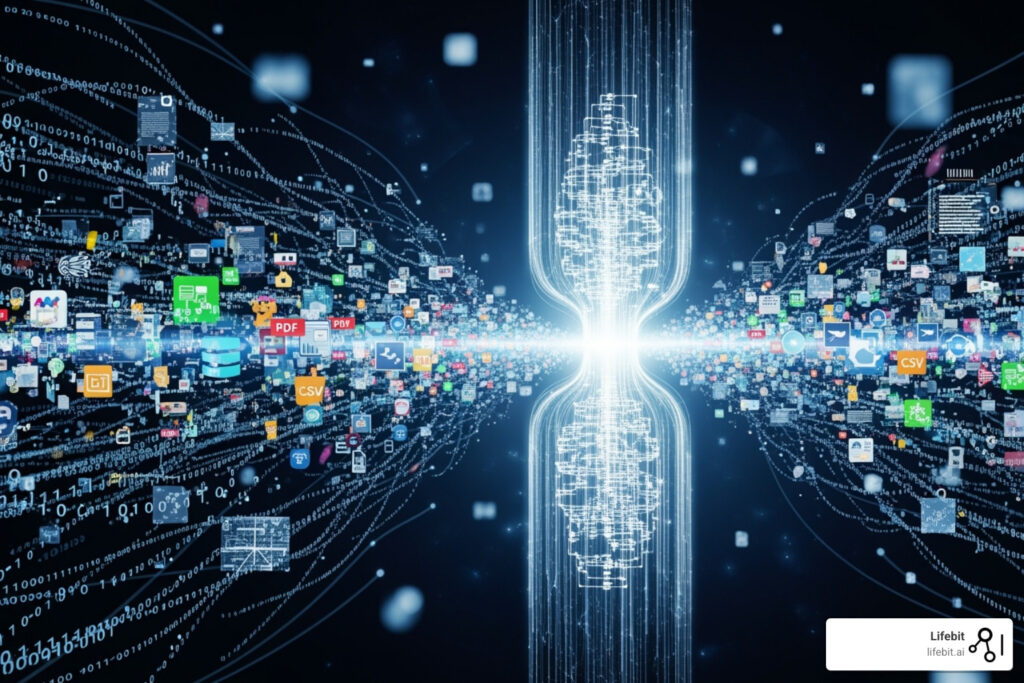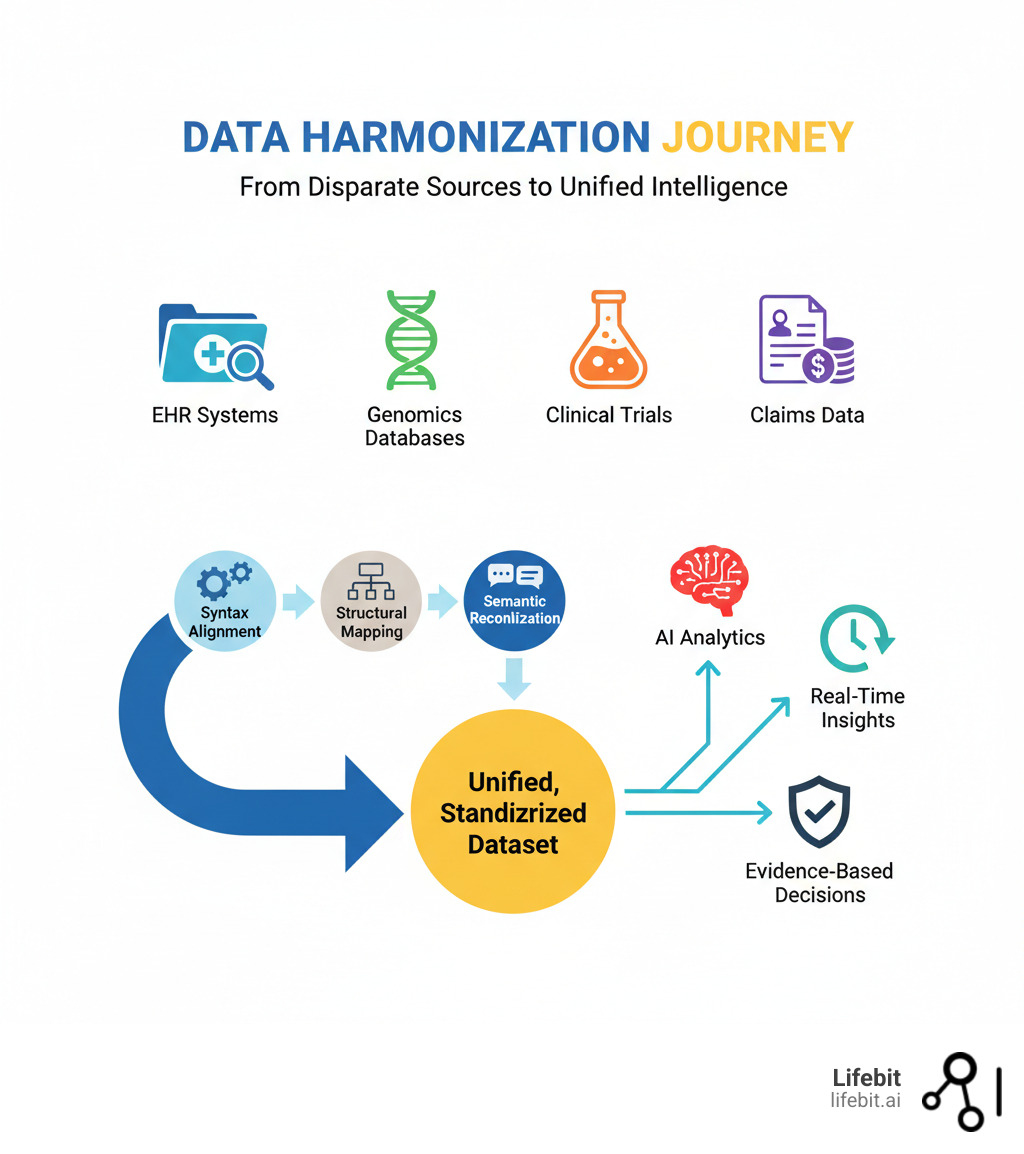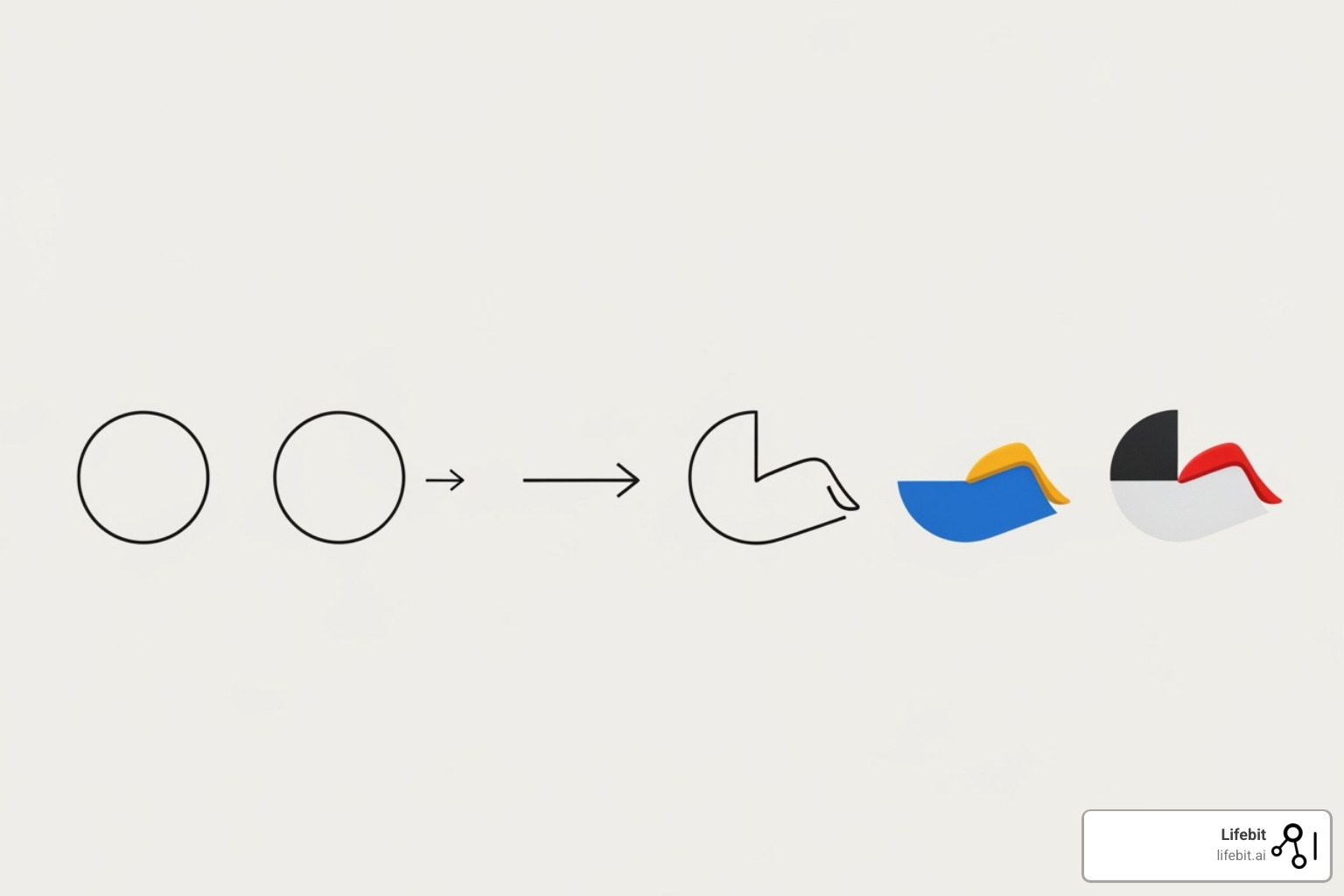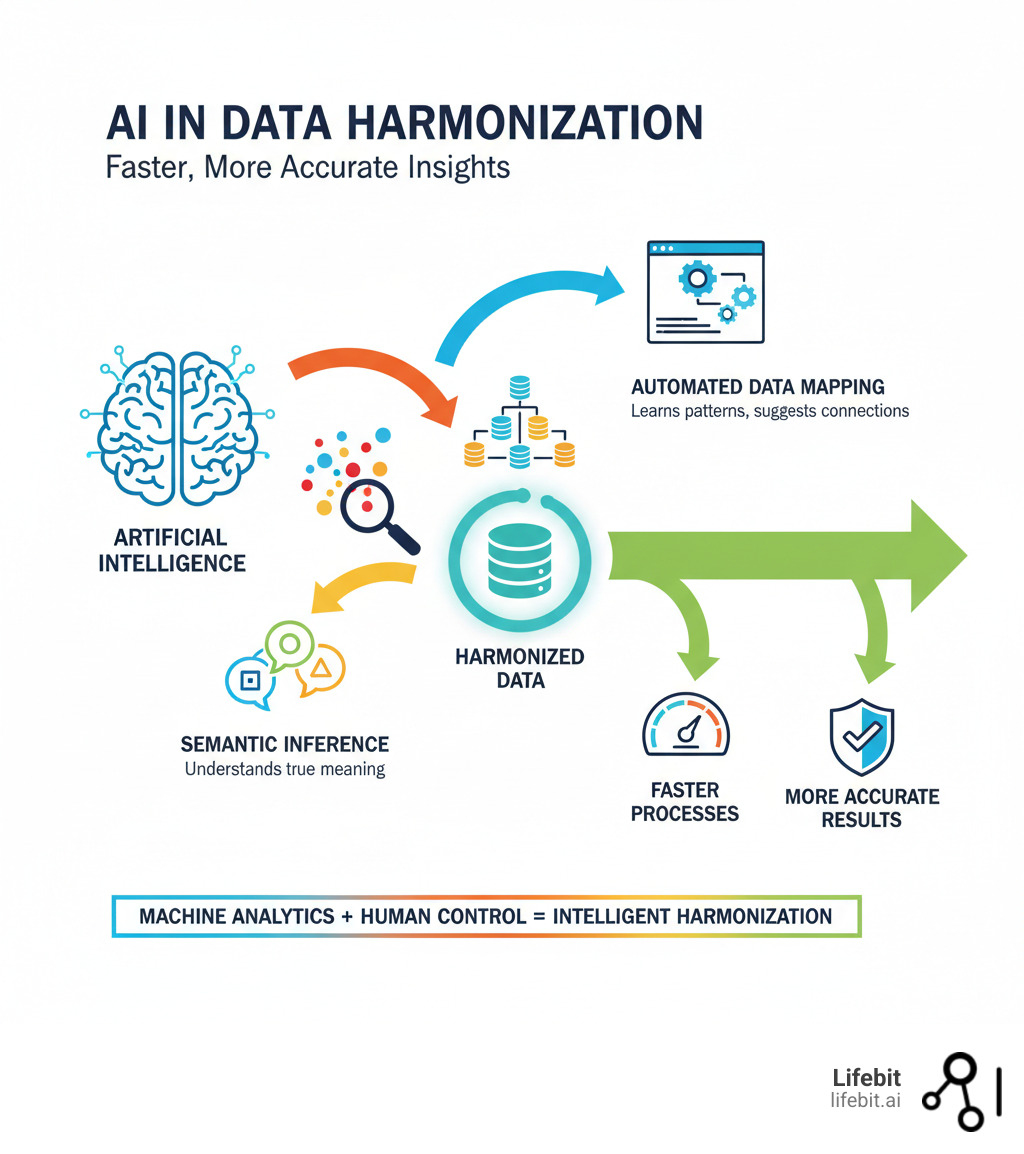Unifying Your Data: The Definitive Guide to Data Harmony

Data Chaos Costs Millions. Harmonization Delivers Insight.
Data harmonization is the process of converting fragmented, inconsistent data from multiple sources into a unified, comparable format. In today’s data-driven world, organizations collect vast amounts of information, but without proper harmonization, this data remains siloed and unusable, costing organizations an average of $13 million annually.
Data harmonization means:
- Converting disparate data into a cohesive, standardized format.
- Resolving differences in syntax (formats), structure (schemas), and semantics (meaning).
- Creating comparability across datasets that were originally incompatible.
- Enabling unified analysis of previously fragmented information.
- Changing raw data into actionable business intelligence.
For global pharma companies and public sector organizations, the stakes are high. Your EHR systems, genomics databases, and clinical trial data are likely trapped in incompatible silos. Without harmonization, you’re making critical decisions based on incomplete information.
As Maria Chatzou Dunford, CEO of Lifebit with over 15 years in biomedical data integration, I’ve seen how true data harmonization transforms an organization’s ability to open up insights from its most valuable asset. Successful harmonization is the foundation for breakthrough findies in healthcare and beyond.

What is Data Harmonization? From Chaos to Comparability
Most organizations face a data landscape in chaos. Information floods in from customer interactions, scientific instruments, and financial systems, but it arrives in different formats and with conflicting definitions. One system calls customers “clients,” another uses “users,” and a third assigns random IDs. It’s like trying to conduct an orchestra where every musician is playing a different song.
Data harmonization brings order to this chaos. At its core, it’s about reconciling disparate sources to create a cohesive dataset that makes sense. It teaches all your data to speak the same language, moving it from a state of heterogeneity to true comparability and usability. This process creates a unified story from fragmented chapters, revealing insights you never knew existed.
As research from the University of Michigan explains, the goal isn’t perfection—it’s actionable insights that drive real business decisions and scientific breakthroughs.
The 3 Layers of Harmonization: Syntax, Structure, and Semantics
To truly harmonize data, you must address three distinct challenges:
- Syntax Resolution: This tackles surface-level inconsistencies in data formats. It’s about enforcing a single, consistent representation for values. For example, ensuring all dates follow a single format (e.g., “YYYY-MM-DD”) instead of a mix of “MM/DD/YYYY” and “20231215”. Other common examples include standardizing phone numbers to a single format like
+1-555-123-4567instead of(555) 123-4567or555.123.4567, and converting all monetary values to a single currency with a consistent format (e.g.,100.00 USDvs.$100). - Structural Mapping: This addresses differences in schema integration. It creates a unified blueprint for your data, defining how different data models relate to one another. A simple example is mapping a single address field into separate columns for street, city, and state. A more complex case involves reconciling different product hierarchies. One system might use
Category > Subcategory > Product, while another usesDepartment > Aisle > SKU. Structural mapping creates a single, logical product hierarchy and defines the rules to transform data from both source systems into it. - Semantic Alignment: This is the deepest and most challenging level, dealing with intended meaning. It ensures that a concept means the same thing across all systems. For example, defining “active customer” as “a user who has purchased in the last 12 months.” This often requires using controlled vocabularies or ontologies to map different terms to a single, authoritative concept. In healthcare, this could mean mapping local lab codes to a universal standard like LOINC or clinical terms to SNOMED CT. This layer requires deep domain expertise to correctly interpret the business context behind the data.
Harmonization vs. Integration vs. Standardization: Know the Difference
These terms are often confused, but they solve different problems. Using the wrong approach is like using a hammer when you need a screwdriver.
| Aspect | Data Harmonization | Data Integration | Data Standardization |
|---|---|---|---|
| Goals | Creates comparability across different sources, ensuring data means the same thing everywhere. | Combines data from various sources into one accessible location. | Enforces conformity to predefined rules and formats within specific systems. |
| Process | Reconciles meaning, context, and structure to enable valid cross-source analysis. | Extracts, transforms, and loads data using ETL/ELT processes or virtualization. | Applies uniform formatting rules and value sets to ensure consistency. |
| Outcome | A cohesive dataset where concepts are equivalent and analysis is meaningful. | A centralized repository or unified view of combined information. | Data that follows specific formats and rules for internal consistency. |
| Analogy | Teaching everyone to speak the same language and agree on what words mean. | Getting everyone into the same room. | Making sure everyone wears the same uniform. |
In short: standardization ensures everyone wears the same uniform, integration gets them in the same room, but harmonization ensures they all speak the same language and work toward the same goal. You often need all three, but harmonization is what enables deep insights from complex, multi-source data.
The $13M Problem: The Cost of Data Chaos vs. The ROI of Harmony
Does this sound familiar? Your research team presents a breakthrough finding, but the numbers don’t match what finance reported. This isn’t just an embarrassing moment—it’s a symptom of a problem that’s draining your resources.
Gartner research reveals that organizations lose an average of $13 million annually due to poor data quality. This represents teams burning hours manually cleaning data, researchers delayed by months reconciling conflicting datasets, and executives making critical decisions based on flawed information.
Data chaos isn’t inevitable. Implementing data harmonization transforms this liability into a powerful strategic asset. The organizations thriving today aren’t just collecting more data—they’re making their data speak the same language.
The Risks of Inconsistent Data
When data harmonization isn’t a priority, the consequences ripple through your organization:
- Inaccurate Reporting: Reports and AI models built on inconsistent data produce misleading predictions and flawed insights.
- Operational Inefficiency: Teams waste time arguing about data definitions instead of analyzing results, leading to duplicated efforts and missed deadlines.
- Poor Strategic Decisions: When leadership can’t trust the data, they resort to guesswork, eroding confidence and leading to costly misfires.
- Escalating Compliance Risks: In regulated industries like pharma, inconsistent data can trigger violations, hefty fines, and reputational damage.
The Rewards of Harmonized Data
Organizations that accept data harmonization gain transformative advantages:
- Reliable Business Intelligence: A 360-degree view of operations allows teams to trust the insights they see, from patient outcomes to market trends.
- Faster Time-to-Insight: Analysts spend less time cleaning data and more time finding patterns that drive innovation, giving you a competitive edge.
- Optimized Operations: When data flows seamlessly between departments—from clinical trials to regulatory submissions—processes become more efficient and automated.
- Enabled Advanced AI/ML: Clean, consistent, harmonized data is the fuel for AI systems that deliver breakthrough insights, not expensive disappointments.
The bottom line is measurable: significant reductions in analysis costs, faster project completion, and the confidence to make data-driven decisions that create real business value.
A 5-Step Blueprint for Flawless Data Harmonization
Data harmonization requires a systematic approach. This five-step blueprint distills years of experience wrangling complex datasets—from genomics research to clinical trials—into a clear, manageable process.

Step 1: Find and Profile Your Data
Before you can fix your data, you need to understand its current state. This step is about taking a full inventory and creating a detailed diagnostic report.
- Identify all data sources: Catalog every relevant database, CRM, ERP, and external feed—including hidden spreadsheets and legacy systems. Don’t forget unstructured sources like text documents or images.
- Assess data quality: Profile the data to find missing values, inconsistent formats, duplicate records, and other errors. This involves column profiling (analyzing data types, value distributions, and outliers), cross-column profiling (checking dependencies), and cross-table profiling (validating relationships).
- Understand metadata and lineage: Investigate what cryptic field names mean, what units are used, and what business rules apply. Crucially, document the data lineage—the data’s origin, what has happened to it, and where it moves over time. This context is vital for accurate harmonization.
- Define your scope: Clearly determine which datasets to harmonize and what business questions you aim to answer. Starting with a high-value, manageable scope is key to demonstrating early success.
Step 2: Design the Target Schema
This is the architectural blueprint for your harmonized data. It’s a critical step that defines how your organization will speak about data in a unified way.
- Establish common standards: Agree on universal data types, naming conventions (e.g., snake_case vs. camelCase), units of measurement, and acceptable value ranges.
- Create a unified data model: Design a target model that accommodates data from all sources. This often involves adopting or creating a Common Data Model (CDM), such as the OMOP CDM in healthcare research, which provides a standardized structure for observational health data. This model defines the target tables, fields, and relationships.
- Involve domain experts: Collaborate with business users from marketing, finance, and research to ensure the schema reflects real-world needs and business logic. Their input is non-negotiable for achieving semantic accuracy.
- Define data governance rules: Establish initial policies for data ownership, access controls, and security protocols to maintain the value and compliance of the future harmonized dataset.
Step 3: Transform and Map the Data
Here, you execute the plan, converting raw, messy data into a clean, consistent asset according to the rules defined in your target schema.
- Cleanse the data: Fix misspellings, standardize casing, and handle missing values using defined strategies (e.g., imputation, removal, or flagging). For duplicates, use both deterministic (exact matches) and probabilistic matching (fuzzy logic) to identify and merge records that are likely the same but have minor variations.
- Map values and structures: Translate different system codes to a single standard (e.g., map both “M” and “1” to “Male”). This also involves structural transformation, like splitting a full name field into
first_nameandlast_nameor pivoting data from a wide to a long format. - Convert units: Standardize all measurements, such as converting currencies to a single denomination (e.g., USD), ensuring all weights are in kilograms, or making sure all dates follow the ISO 8601 format.
- Use ETL/ELT processes: Employ automated pipelines to extract data from sources, apply your transformation logic, and load it into the harmonized repository. Modern tools allow for complex, repeatable, and version-controlled transformations.
Step 4: Validate and Reconcile
Just because the process ran doesn’t mean the data is perfect. This quality control step is essential for building trust in the final output.
- Run data quality checks: Programmatically verify that the harmonized data conforms to your target schema, data types, and value constraints. Check for things like nulls in required fields or values outside of defined ranges.
- Use anomaly detection: Apply statistical methods or machine learning to identify unusual patterns that might indicate transformation errors (e.g., a sudden spike in customers from Antarctica or a drop in average transaction value).
- Reconcile and get business sign-off: Investigate and fix any discrepancies found. This often involves a feedback loop with domain experts. Present summary statistics and sample data to business users to confirm the harmonized data aligns with their expectations and is fit for purpose.
- Confirm accuracy: Ensure the final dataset is complete, accurate, and trustworthy before releasing it for analysis. Compare aggregate metrics (e.g., total sales, patient counts) between source and target to ensure no data was lost.
Step 5: Govern and Maintain the Harmonized Data
Data harmonization is not a one-time project. It requires ongoing care and governance to remain valuable as data sources and business needs evolve.
- Implement data governance: Formalize roles and responsibilities for data ownership, stewardship, and usage. This ensures accountability for data quality.
- Monitor data quality continuously: Use automated dashboards and alerts to track key quality metrics and catch issues like data drift or upstream schema changes early.
- Create a business glossary: Develop and maintain a data dictionary or business glossary that defines each element in the harmonized dataset. This serves as a single source of truth for data consumers, promoting consistent interpretation and use.
- Establish maintenance workflows: Create processes to handle new data sources, evolving business rules, and system changes. Harmonization logic must be updated to reflect these changes.
- Use version control: Track changes to your data models and transformation logic using tools like Git. This ensures traceability, reproducibility, and allows for rollbacks if needed.
How Industry Leaders Win with Harmonized Data
The power of data harmonization becomes clear when you see it in action. Across industries, organizations are turning fragmented information into a strategic asset, creating measurable business value.
Healthcare & Life Sciences: Accelerate Research
In healthcare, data is often trapped in incompatible systems like EHRs, lab information systems (LIMS), and clinical trial databases. Harmonization creates a unified view that enables breakthrough discoveries.
- Multi-omics Data Integration: The challenge here is immense. A single patient can generate terabytes of data from genomics (DNA), transcriptomics (RNA), proteomics (proteins), and metabolomics (metabolites). Harmonizing this data—which comes in vastly different formats and scales—allows researchers to build a holistic molecular picture of a disease, leading to unprecedented insights into its mechanisms and potential therapeutic targets.
- Clinical Trial Data Pooling: Harmonizing data across multiple studies, often from different sponsors and countries, increases statistical power. This is critical for identifying subtle drug effects, studying rare diseases, and validating findings in diverse populations, ultimately speeding up the path to regulatory approval.
- Real-World Evidence (RWE) Generation: Unifying EHRs, insurance claims data, and patient registries creates a comprehensive picture of how treatments perform outside the controlled environment of a clinical trial. This improves pharmacovigilance by enabling the early detection of rare adverse events and informs value-based care decisions.
An excellent example is the National COVID Cohort Collaborative (N3C), which harmonized EHR data from institutions across the US to enable rapid scientific discovery during the pandemic. Read more about the N3C’s design here.
Finance: Build a 360-Degree Customer View and Manage Risk
Financial institutions use harmonization to create a complete picture of each customer and manage systemic risk.
- Sophisticated Risk Management: Regulations like BCBS 239 (the Basel Committee on Banking Supervision’s principles for effective risk data aggregation) mandate that global banks have a comprehensive and timely view of risk. Harmonization is the foundation for achieving this, enabling banks to aggregate risk exposures across all business lines, legal entities, and geographies to produce accurate reports for regulators and internal management.
- Improved Fraud Detection: By harmonizing transaction data from all channels (online, mobile, in-person), algorithms can spot complex, suspicious patterns that would otherwise be invisible. This allows for a shift from reactive to proactive fraud prevention.
- Personalized Products: A complete, harmonized customer view—combining account information, transaction history, loan data, and customer service interactions—reveals opportunities to offer relevant products and services that meet individual needs, increasing customer lifetime value.
Manufacturing: Enable the Smart Factory
For manufacturers, data harmonization is key to realizing the promise of Industry 4.0.
- Predictive Maintenance: By harmonizing data from IoT sensors on machinery, maintenance logs, and production schedules, companies can build models that predict equipment failure before it happens. This minimizes unplanned downtime, reduces repair costs, and extends the life of expensive assets.
- Supply Chain Optimization: Harmonizing data from suppliers, inventory management systems, logistics partners, and sales forecasts provides an end-to-end view of the supply chain. This enables smarter inventory decisions, reduces waste, and improves resilience to disruptions.
- Quality Control Improvement: Combining data from quality control sensors on the production line with data on raw material inputs and environmental conditions helps identify the root causes of product defects, leading to higher yields and greater customer satisfaction.
Retail: Optimize Supply Chains & Personalization
For retailers operating across multiple channels, harmonization provides a true picture of performance.
- Unified Sales and Inventory: Harmonizing data from e-commerce platforms, physical stores, and mobile apps drives smarter inventory decisions, reducing stockouts and overstock situations to improve profit margins.
- Deep Customer Behavior Analysis: Combining sales data with website analytics, social media sentiment, and loyalty programs creates detailed customer profiles for highly effective, personalized marketing campaigns and product recommendations.
Advanced Harmonization: AI, MDM, and Strategic Trade-offs
As organizations mature, they move beyond simple data cleaning to building intelligent, self-optimizing data ecosystems. This involves combining advanced AI with strategic frameworks to create harmony that scales and adapts, a critical step in complex fields like biomedical research.
AI’s Role in Smart Harmonization
Artificial Intelligence is revolutionizing data harmonization by automating and accelerating the process.
- Automated Data Mapping: AI algorithms learn from existing mappings to suggest new connections between disparate schemas, drastically reducing manual effort.
- Anomaly Detection: Machine learning spots inconsistencies and outliers in massive datasets—like impossible vital signs in a patient record—that humans would miss.
- Semantic Inference: AI can infer the true meaning of data elements even when terminology differs, recognizing that “adverse event severity” and “AE grade” are equivalent.
AI enables the scaling of sophisticated harmonization tasks, such as using deep learning to reconcile MRI data from different scanners. This allows researchers to combine data from multiple sites for more powerful studies.

Modern harmonization blends machine analytics with human oversight, combining technical precision with business expertise.
How Harmonization Enables Master Data Management (MDM)
Data harmonization and Master Data Management (MDM) are deeply connected. MDM aims to create a “golden record”—a single source of truth for critical business data like customers or patients.
However, you can’t create a golden record without harmonization first. Harmonization is the engine that transforms messy, inconsistent source data into the clean, comparable information that MDM organizes into authoritative master records. The result is improved data quality and redundancy elimination, ensuring decisions are based on reliable information.
The Trade-off: Harmonize Existing Data or Re-collect?
Organizations must often choose between harmonizing existing data or starting fresh with new collection. It’s a strategic trade-off.
- Harmonization is often faster and more cost-effective, especially for analyzing historical data that cannot be re-collected.
- Re-collection may be better if existing data quality is extremely poor or missing critical elements. It allows you to capture exactly the level of detail required.
There is also an information trade-off: harmonization can sometimes mean reducing data to the “least common denominator,” losing some original detail. The right choice depends on your project goals, budget, and timeline. At Lifebit, our federated platform supports both approaches, enabling secure harmonization of existing global data while also supporting new data collection efforts.
Your Data Harmonization Questions, Answered
Here are answers to the most common questions about data harmonization.
What is the difference between data harmonization and ETL?
ETL (Extract, Transform, Load) is the technical process; data harmonization is the strategic goal.
ETL is the machinery that moves data. The “Transform” step in ETL is where harmonization often happens, but you can run ETL processes without achieving true harmonization. Harmonization focuses on semantic consistency and comparability—ensuring data tells a coherent story—not just moving it from point A to point B.
Can data harmonization be fully automated?
No, but intelligent automation is key. AI and machine learning are game-changers for handling the heavy lifting, like spotting patterns and suggesting mappings at scale. For massive datasets, this is essential.
However, human expertise remains irreplaceable, especially in complex domains like biomedical research. Domain experts must define the business rules, validate the outcomes, and make judgment calls on ambiguous data. The most effective approach combines powerful automation with expert human oversight.
How do you measure the success of a data harmonization project?
Success is measured by business impact, not just technical completion. Key metrics include:
- Data Quality Metrics: Track improvements in data completeness, accuracy, and consistency. Are there fewer errors and missing values?
- Time Savings: Measure the reduction in time your analysts spend on data preparation. A shift from weeks to hours is a clear win.
- User Adoption: Are teams actively using the harmonized datasets? Increased usage and positive feedback are strong indicators of success.
- Business Impact & ROI: Connect the project to tangible outcomes like reduced operational costs, faster decision-making, or new analytical capabilities. Can you now run analyses that were previously impossible? Calculate the return on investment by comparing these benefits to the project costs.
Stop Drowning in Data. Start Driving Findy.
Data chaos is a choice. Continuing with fragmented, inconsistent data means leaving money on the table, insights in the dark, and opportunities unexplored.
Harmonization is the bridge between simply having data and using it to drive real results. When your teams trust the numbers, your AI models are built on clean information, and your leaders make decisions from a single source of truth, data becomes your competitive weapon.
For organizations in life sciences, this is even more critical. Lives depend on getting the data right. A unified data foundation is essential for advanced AI, reliable research, and effective pharmacovigilance. Without it, you’re building on quicksand.
At Lifebit, we’ve seen how the right approach transforms research programs. Our federated platform enables secure, large-scale data harmonization for complex biomedical data, allowing researchers to collaborate across institutions while maintaining the highest standards of privacy and compliance.
The choice is yours: continue wrestling with inconsistent data, or take the step toward harmony. Your data is waiting to become your most valuable asset.
Ready to see what harmonized data can do for your organization? See how Lifebit can unify your data and turn information into insight, faster than you thought possible.

